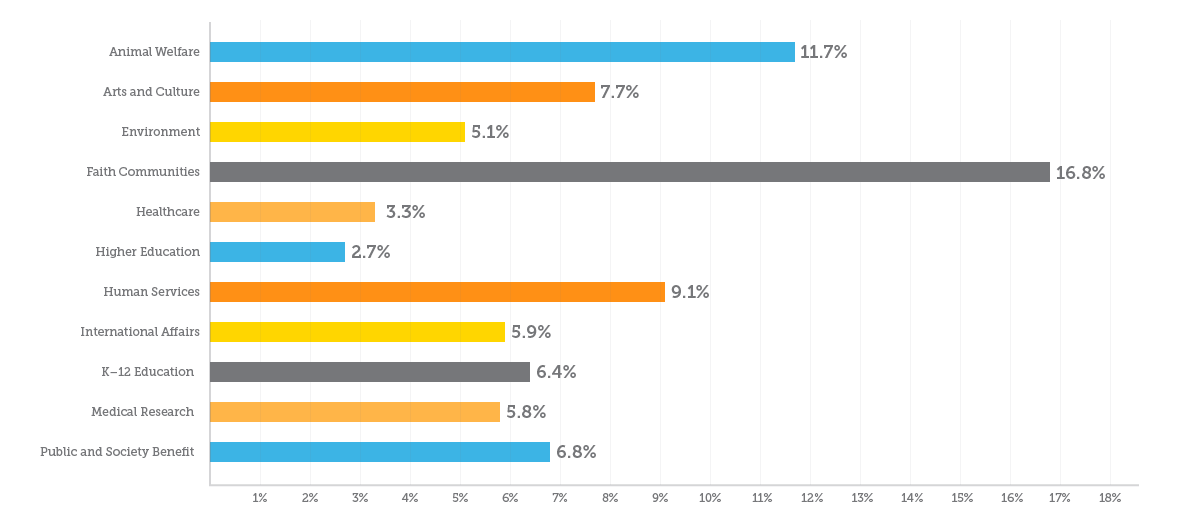
Why Direct Mail
Can print compete in a digital world?
Is donor mail right for your nonprofit?
For most nonprofits, the answer is a resounding “YES.” But with all the hype surrounding digital fundraising, using a traditional tool like donation letters can seem counterintuitive. What’s the reality?
Online giving is growing, but as of 2021 it was still only 12 percent of total fundraising overall. That’s according to the Blackbaud Charitable Giving Report.
The truth is it’s going to be years before the balance tips away from traditional formats like direct mail. Why?
2021 Percentage of Total Fundraising from Online Giving by Sector
Source: Blackbaud Institute 2021 Charitable Giving Report
Reason #1: People trust traditional formats more when making purchase decisions.
The top five most trusted advertising formats are all traditional tactics, according to a MarketingSherpa survey of 1,200 consumers. Three in four people said they trusted direct mail (76%). While less than half of respondents (43%) picked social media.
What’s more, tech companies are driving the new growth in traditional formats as they (ironically!) promote things like Google Ads via direct mail. It’s their preferred way to cut through the digital clutter.
Reason #2: The average U.S. donor is age 65.
She can hold mail in her hand, keep it on her desk, read it again, and decide how she wants to give – by check or online. In fact, donors are THREE times more likely to give online in response to a direct mail appeal than an emailed appeal. (Source: MobileCause).
It’s also important to keep in mind that while younger donors are digital natives, they still read and enjoy direct mail. Read 5 Facts About Millennials & Direct Mail.
Reason #3: Response rates (in monetary gifts) to online fundraising are much lower than direct mail.
It’s easy to get lost in the flurry of digital metrics. The bottom line is that open rates, click throughs, likes, comments, and shares are useful indicators — but they’re not money in the bank.
A direct mail letter to a house list (existing donors in your database) is still 75-112% more effective in raising money, on average, than the best performing digital tactic: email.
-

Average response rate to fundraising letter. (house list)
(Source: Data & Marketing Association 2018)
-

Average response rate to fundraising email. (house list)
(Source: M+R Benchmarks 2022)
-

Average return on $1 social media ad spend.
(Source: M+R Benchmarks 2022)
Mix direct mail & digital for larger response
Luckily, most nonprofits don’t have to choose between direct mail vs. digital. Nor should they … because a magical multiplier effect happens when you mix these tactics in a well-crafted integrated campaign.
Average Response Rates of Integrated Campaigns
Chart Sources: 2021 M+R Benchmarks Report and 2020 MobileCause Fundraising Statistics/Japs-Olson Company
What about Facebook?
Facebook is the social champ for fundraising. The platform generated 1.1% of all online revenue for nonprofits in 2021, according to M+R Benchmarks 2022. Nearly all of that income was generated via the platform’s peer-to-peer fundraising tool. The average Facebook fundraiser generated five gifts, with an average gift size of $35.
But unlike your email system, Facebook won’t share your donors’ contact information with you for later use. That data is too valuable to the company’s advertising platform.
Should your in-house team manage direct mail?
That depends on what else is on their plates. Donation letters that perform well take time, focus, and specialized knowledge to get right.
You need to know dozens of quirky things like how to write a good Johnson box, apply ask string strategy, use printer terminology, and get the best postage rates. Those tricks of the direct mail trade help drive down your costs per piece and increase your return on investment.
Bottom line
Your team can learn to do direct mail, and we have free resources to help. But once you reach at least 500 pieces to mail, it starts making sense to save your team’s time for higher-level tasks and to outsource your donation letters to people who do direct mail every day.
“The team never wants to do another campaign without Abeja’s support!”

or






